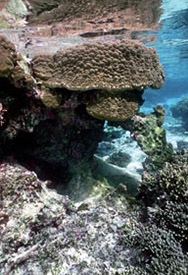Diving in the National Park of America Samoa
American Samoa is a volcanic archipelago of five islands located 14 degrees south of the equator. This is the southernmost territory of the United States, and is not to be confused with Western Samoa, 50 miles to (you guessed it) the west. The latter has strong cultural ties to American Samoa but is an independent nation.
Samoa is strikingly beautiful in its physical geography, with steep, verdant cliffs dropping to the sea, their bases surrounded by mixes of cobble and white-sand beaches. The coral communities that fringe the islands are far more diverse than those in the Caribbean basin.
The National Park has units on three of the islands including Tutuila, Ta'U, and Ofu. All three are worth visiting but Ofu has the best diving in its beautiful coral garden. The Ta'U unit of the park has a spectacular rain forest, which you should be sure to visit. The forested park unit on Tutuila shares the island with Rainmaker Mountain-and, not surprisingly, gets plenty of rain. To get a feel for the humid essence of the tropics without getting wet, read Somerset Maugham's Rain, the setting for which is Pago Pago on Tutuila. Pago Pago is also the location of the Jean P. Haydon Museum with exhibits about Samoan cultural and natural history.
Somerset Maugham is only one of a number of authors who became fascinated with the South Seas. Perhaps the most famous is Robert Louis Stevenson, who spent the last four years of his life in Western Samoa. In fact, to paraphrase the requiem he wrote for himself, it is under the Samoan wide and starry sky that they dug his grave and let him lie. Anthropologist Margaret Mead wrote her classic study, Coming of Age in Samoa, on this island as well. More recently, travel writer Paul Theroux visited American Samoa and in his very popular book, The Happy Isles of Oceania, he described Samoans as "victimizers, oafish, lazy and disrespectful.” We do not share Mr. Theroux's harsh assessment of the Territory or its people, and have found them generally friendly and helpful, particularly in the out-islands.
If you are going to be exploring the less popular beaches on the islands it is a good idea to contact the local village chief and politely request permission to be there. All of these beaches are owned by local families or chiefs, and they can be friendly or less so depending on how they feel about strangers trespassing on their property.
BASICS
Location: Western Pacific
Skill level: Beginner-intermediate
Access: Shore and boat
Dive support: Pago Pago
Best time of year: Fall
Visibility: 30-100 feet
Highlights: Tropical reefs, shipwrecks
Concerns: None
Rules and Regulations
Dive Overview
To dive Samoa, one must first reach it. The bad news is that it takes a seven-hour flight from Honolulu on Hawaiian Air to get there. The good news is there is quite a bit to see and do in these islands and you can get your reading done on the flight over.
Diving is possible from all three units of the park, but Ofu is by far the best. The diving off Ta'U has little to recommend it: it's exposed, there's lots of surge, and prevailing winds make beach approaches dicey. The park unit
on Tutuila has decent diving conditions but only a mediocre assortment of bottom features with minimal coral. There are good dive sites around Tutuila that are not associated with the park. For information on these, check with the local dive shop in Pago Pago.
The diver should note that a National Marine Sanctuary is in an early stage of development in American Samoa waters. The Fagatele Bay NMS should eventually generate good educational materials on marine life in the area.
Exploration of the coral reef in park waters is highly recommended and easily accomplished. Just a short drive from the airstrip is superb snorkeling, and a delightful place to stay in a stone’s throw from where the plane will take off. Don't let the proximity of the "airport" worry you. This is not LAX: here you'll see vacationers lounging in deck chairs on the landing strip.
DIVING RULES AND REGULATIONS
Diver-down flag must be displayed while divers are in the water. Removal of artifacts is prohibited.
Last Updated: October 26, 2012








